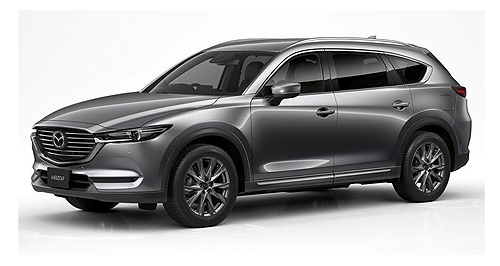Future models - Mazda - CX-8Mazda adds petrol engines to Japanese-market CX-8Incoming model-year update may give Mazda CX-8 buyers access to petrol power29 Oct 2018 MAZDA Australia may soon add two petrol engines to its CX-8 seven-seat large SUV as part of a broader model-year update that has just been confirmed for the Japanese market.
Until now, the CX-8 was exclusively motivated by a 140kW/450Nm 2.2-litre twin-turbocharged diesel unit, but buyers in Mazda’s home market Japan now have access to a pair of 2.5-litre four-cylinder engines.
One of the units, taken from the CX-5 five-seat mid-size SUV, uses natural aspiration to produce 140kW at 6000rpm and 252Nm at 4000rpm, while cylinder deactivation helps to improve its fuel efficiency.
The other engine, borrowed from the CX-9 seven-seat large SUV, employs a single turbocharger to develop 170kW at 4250rpm and 420Nm at 2000rpm. Both options are matched to a six-speed automatic transmission.
Claimed fuel consumption on the new Worldwide harmonised Light vehicle Test Procedure (WLTP) combined cycle test for the atmo and blown units are 8.1 and 8.6 litres per 100 kilometres respectively.
When asked by GoAuto whether the petrol CX-8 was being considered for a local launch, Mazda Australia senior manager of public relations Sonia Singh said: “We only just received the CX-8 in Australia – a lot later than Japan – so we don’t have any updates to announce at this stage.”
However, given that the diesel-only CX-8 and petrol-only CX-9 cater to a significant number of buyers shopping in the large-SUV segment, it seems unlikely that the petrol units will be offered in the local market.
As reported, the CX-9 is available in Australia but not Japan, which would explain why Mazda has made the move to expand the overseas CX-8 line-up with petrol engines.
What is more certain, however, is the introduction of the rest of the CX-8’s model-year update, which mirrors that of the Japanese-market CX-5 earlier this month and focuses on dynamics and upgraded equipment levels.
The CX-8 now gains G-Vectoring Control (GVC) Plus, which applies light braking force to the outside wheels when exiting a corner, providing extra stability as the driver straightens up the steering wheel.
Mazda claims GVC Plus also allows the CX-8 to better respond to sudden steering inputs, such as those made during collision avoidance manoeuvres or when driving on slippery surfaces.
The CX-8’s autonomous emergency braking (AEB) system now also detects pedestrians at night, while a 360-degree camera, ventilated front seats, Apple CarPlay and Android Auto support, a 7.0-inch digital instrument cluster, a frameless rearview mirror and white LED ambient lighting have become available.
Fresh 17- and 19-inch alloy wheel designs have also been introduced, while tweaked climate controls, a 15mm-lower front centre armrest, and extra sound insulation in the tailgate and boot floor have been added inside.
For reference, pricing for the current CX-8 line-up ranges from $42,990 before on-road costs for the front-wheel-drive Sport to $61,490 for the all-wheel-drive Asaki.
Following its launch in late-June this year, Mazda has recorded 895 CX-8 sales to the end of September, making it the 18th best-selling model in the highly competitive sub-$70,000 large-SUV segment.
The CX-8’s tally has helped Mazda increase its segment share to 8.7 per cent, although Toyota’s Prado (14,239 units) and Kluger (11,109) remain at the top of the class.  Read moreAll future models Alfa Romeo Alfa Romeo Abarth Abarth Audi Audi Aston Martin Aston Martin BMW BMW Bentley Bentley Chrysler Chrysler Chevrolet Chevrolet Dodge Dodge Citroen Citroen Ferrari Ferrari DS DS Ford Ford Fiat Fiat FPV FPV Foton Foton Haval Haval Great Wall Great Wall Honda Honda Holden Holden Hyundai Hyundai HSV HSV Isuzu Isuzu Infiniti Infiniti Jeep Jeep Jaguar Jaguar Lamborghini Lamborghini Kia Kia Lexus Lexus Land Rover Land Rover Mazda Mazda Maserati Maserati Mercedes-Benz Mercedes-Benz McLaren McLaren Mini Mini Nissan Nissan Mitsubishi Mitsubishi Peugeot Peugeot Opel Opel Proton Proton Porsche Porsche Renault Renault Ram Ram Saab Saab Rolls-Royce Rolls-Royce Smart Smart Skoda Skoda Subaru Subaru SsangYong SsangYong Tesla Tesla Suzuki Suzuki Toyota Toyota Volvo VolvoMotor industry news |
Click to shareMazda modelsResearch Mazda All future models Alfa Romeo Alfa Romeo Abarth Abarth Audi Audi Aston Martin Aston Martin BMW BMW Bentley Bentley Chrysler Chrysler Chevrolet Chevrolet Dodge Dodge Citroen Citroen Ferrari Ferrari DS DS Ford Ford Fiat Fiat FPV FPV Foton Foton Haval Haval Great Wall Great Wall Honda Honda Holden Holden Hyundai Hyundai HSV HSV Isuzu Isuzu Infiniti Infiniti Jeep Jeep Jaguar Jaguar Lamborghini Lamborghini Kia Kia Lexus Lexus Land Rover Land Rover Mazda Mazda Maserati Maserati Mercedes-Benz Mercedes-Benz McLaren McLaren Mini Mini Nissan Nissan Mitsubishi Mitsubishi Peugeot Peugeot Opel Opel Proton Proton Porsche Porsche Renault Renault Ram Ram Saab Saab Rolls-Royce Rolls-Royce Smart Smart Skoda Skoda Subaru Subaru SsangYong SsangYong Tesla Tesla Suzuki Suzuki Toyota Toyota Volvo VolvoMotor industry news |
















Facebook Twitter Instagram